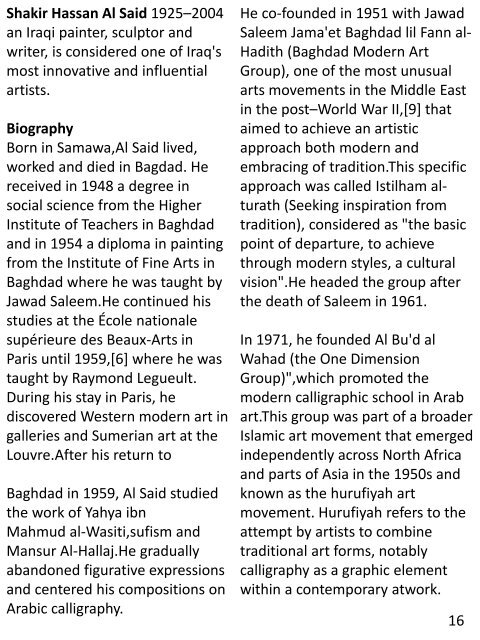Aziz art May 2018
History of art(west and middle east)- contemporary art#Shirazeh Houshiary
History of art(west and middle east)- contemporary art#Shirazeh Houshiary
You also want an ePaper? Increase the reach of your titles
YUMPU automatically turns print PDFs into web optimized ePapers that Google loves.
Shakir Hassan Al Said 1925–2004<br />
an Iraqi painter, sculptor and<br />
writer, is considered one of Iraq's<br />
most innovative and influential<br />
<strong>art</strong>ists.<br />
Biography<br />
Born in Samawa,Al Said lived,<br />
worked and died in Bagdad. He<br />
received in 1948 a degree in<br />
social science from the Higher<br />
Institute of Teachers in Baghdad<br />
and in 1954 a diploma in painting<br />
from the Institute of Fine Arts in<br />
Baghdad where he was taught by<br />
Jawad Saleem.He continued his<br />
studies at the École nationale<br />
supérieure des Beaux-Arts in<br />
Paris until 1959,[6] where he was<br />
taught by Raymond Legueult.<br />
During his stay in Paris, he<br />
discovered Western modern <strong>art</strong> in<br />
galleries and Sumerian <strong>art</strong> at the<br />
Louvre.After his return to<br />
Baghdad in 1959, Al Said studied<br />
the work of Yahya ibn<br />
Mahmud al-Wasiti,sufism and<br />
Mansur Al-Hallaj.He gradually<br />
abandoned figurative expressions<br />
and centered his compositions on<br />
Arabic calligraphy.<br />
He co-founded in 1951 with Jawad<br />
Saleem Jama'et Baghdad lil Fann al-<br />
Hadith (Baghdad Modern Art<br />
Group), one of the most unusual<br />
<strong>art</strong>s movements in the Middle East<br />
in the post–World War II,[9] that<br />
aimed to achieve an <strong>art</strong>istic<br />
approach both modern and<br />
embracing of tradition.This specific<br />
approach was called Istilham alturath<br />
(Seeking inspiration from<br />
tradition), considered as "the basic<br />
point of dep<strong>art</strong>ure, to achieve<br />
through modern styles, a cultural<br />
vision".He headed the group after<br />
the death of Saleem in 1961.<br />
In 1971, he founded Al Bu'd al<br />
Wahad (the One Dimension<br />
Group)",which promoted the<br />
modern calligraphic school in Arab<br />
<strong>art</strong>.This group was p<strong>art</strong> of a broader<br />
Islamic <strong>art</strong> movement that emerged<br />
independently across North Africa<br />
and p<strong>art</strong>s of Asia in the 1950s and<br />
known as the hurufiyah <strong>art</strong><br />
movement. Hurufiyah refers to the<br />
attempt by <strong>art</strong>ists to combine<br />
traditional <strong>art</strong> forms, notably<br />
calligraphy as a graphic element<br />
within a contemporary atwork.<br />
16


















